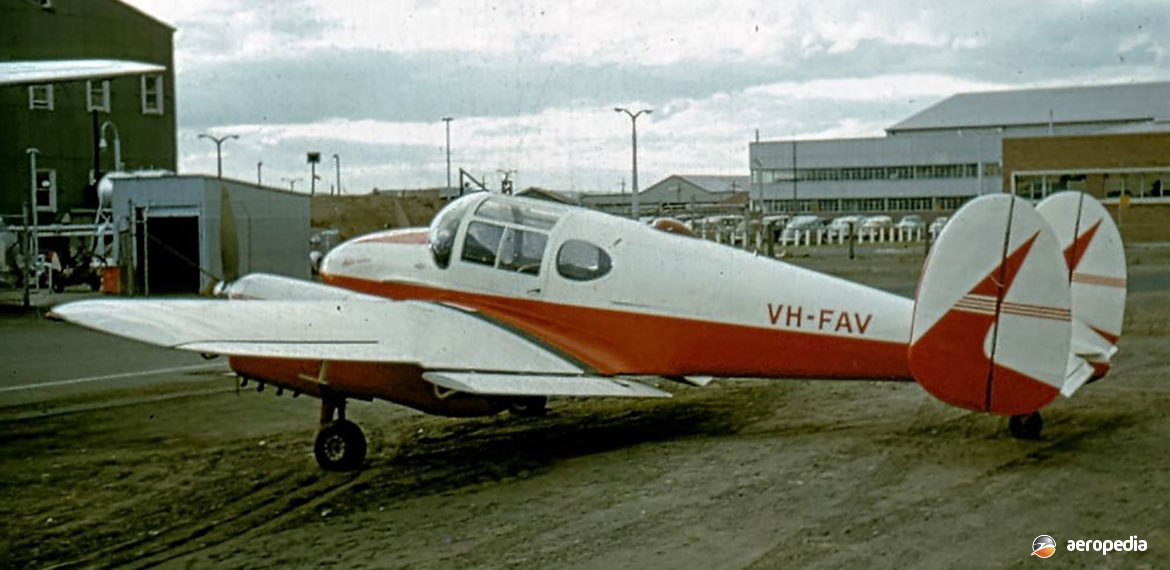Photograph:
Miles Aries VH-FAV (c/n 75/1002) at Mascot, NSW in 1960 (David C Eyre)
Country of origin:
United Kingdom
Description:
Four-seat light twin-engine cabin monoplane
Power Plant:
Two 116 kw (155 hp) Blackburn Cirrus Major III four-cylinder inverted in-line air-cooled engines
Specifications:
- Wingspan: 11.03 m (36 ft 2 in)
- Length: 6.85 m (22 ft 5 in)
- Height: 2.28 m (7 ft 6 in)
- Wing area: 17.74 m² (191 sq ft)
- Max speed at 305 m (1,000 ft): 277 km/h (172 mph)
- Cruising speed at 305 m (1,000 ft): 241 km/h (150 mph)
- Rate of climb: 335 m/min (1,100 ft/min)
- Rate of climb on one engine: 55 m/min (180 ft/min)
- Service ceiling: 4,877 m (16,000 ft)
- Take-off distance to clear 15 m (50 ft): 389 m (1,275 ft)
- Landing run: 165 m (540 ft)
- Range: 1,086 km (675 miles)
- Empty weight: 1,117 kg (2,462 lb)
- Disposable load: 459 m (1,013 lb)
- Loaded weight: 1,576 kg (3,475 lb)
History:
The Aries was a venture by F G Miles Ltd to improve the Gemini four-seat private aircraft. The prototype first flew in February 1951, being shown at RAF Hendon in July 1951, later becoming G-AMDJ (c/n 1002), receiving its Certificate of Airworthiness on 13 June 1952. A Gemini had been fitted with Gipsy Major engines as the Mk 3 and, working at Redhill, F G Miles thought he could improve the design with the installation of Cirrus Major III engines in the three airframes he bought following the demise of Miles Aircraft. Larger fins and rudders were built and the structure received some overall strengthening. A new model number (M.75) was allotted and it was named Aries.
It was a low wing cantilever monoplane, the wing being of spruce construction covered in plywood. Flaps were fitted as standard. The fuselage was also of spruce structure with plywood covering. The tail unit was of the cantilever type with the elevator at the top of the fuselage with two fins and rudders, the fins being at the ends of the tailplane. It had a retractable undercarriage, the main wheels and legs retracting to the rearward into the engine nacelles. Seating was for four in an enclosed cabin with a door on the port side. Some problems occurred with the elevator during testing due to flutter necessitating some re-design and rebuilding.
In 1956 a further Aries was built at Shoreham, UK as G-AOGA and was delivered to Pasolds Ltd. This aircraft (c/n 75/1007) was flown in Ireland where it became EI-ANB. It operated there from near Kilbrittain Castle in County Cork until the 1960s when it was retired and presented to the Irish Aviation Museum in Dublin, being placed in storage until suitable accommodation was available for display.
One Miles M.75 Aries (the prototype) became VH-FAV (c/n 75/1002 – ex G-AMDJ, G-35-1). This machine operated in the United Kingdom for a few years before being imported to Australia and was first registered to G B S Falkiner in Sydney in March 1955. It was initially based at Mascot, and later at Bankstown, NSW. Following a department directive it was retired on 31 December 1963 and afterwards was placed, engineless, on the Great Western Highway west of Sydney at the premises of Penfolds Wines in a vertical position on a stand where it remained until destroyed by fire.
One Gemini was fitted with Cirrus Major II engines and basically modified to Aries specifications, initially being known as a Gemini but later being re-designated as an M.75 Aries. In 1957 it was lost when it suffered an engine failure on take-off.

